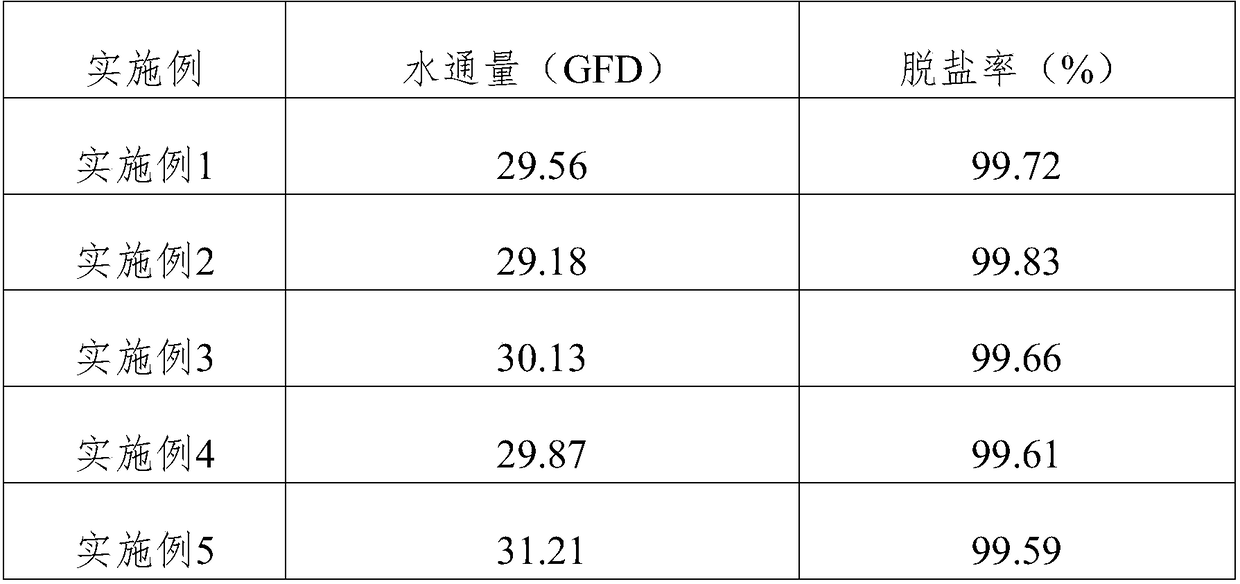Preparation method of high-throughput nano-composite seawater desalination membrane
A nano-composite, high-throughput technology, applied in chemical instruments and methods, seawater treatment, general water supply conservation, etc., can solve the problems of failure to form water flux compression resistance, stability, etc. The effect of sufficient reaction and accelerated reaction rate
- Summary
- Abstract
- Description
- Claims
- Application Information
AI Technical Summary
Problems solved by technology
Method used
Image
Examples
Embodiment 1
[0019] (1) Assemble the reaction bottle in an ice-water bath, add 720ml of concentrated sulfuric acid, then add 6g of nano-graphite powder into the reaction bottle, and finally add 36g of potassium permanganate slowly, control the reaction temperature not to exceed 20°C, and stir for a while Afterwards, raise the temperature to 60°C and continue to stir for 12 hours. After the reactants are cooled to room temperature, add 2L of deionized water and 20mL of 30% hydrogen peroxide in sequence, stir, and then wash the filter cake with 10% dilute hydrochloric acid for 3 times and suction filter , centrifuged, repeatedly washed with deionized water until the supernatant is neutral, centrifuged, and the final centrifuged product was dried in a vacuum at 60°C for 48 hours to obtain nano-graphene oxide;
[0020] (2) Add nano-graphene oxide and TEPA with a mass ratio of 3:1 into a reaction flask containing methanol, after ultrasonic dispersion, react at 85°C for 12h, filter, dry, grind an...
Embodiment 2
[0027] (1) Step (1) (2) is the same as embodiment 1;
[0028] (3) Preparation of polymer solution: weigh 36g of polysulfone, 16g of methyl cellulose, and 0.8g of modified nano-graphene oxide, mix and dissolve them in 147.2g of DMF, stir at 150°C for 6 hours at high speed, then transfer to a vacuum, statically Put defoaming, obtain polymer solution;
[0029] (4) Preparation of base film: After the water bath temperature rises to 80°C, the polymer solution in step (3) is subjected to liquid-solid phase conversion reaction on the non-woven fabric for 0.5min, and then the water bath temperature is lowered to 18°C for full reaction After that, the preparation of the polymer base film is completed, and then the base film is soaked and stored in deionized water, and the film thickness is about 5.5mil;
[0030] (5) After weighing 35g m-phenylenediamine, 1gTEPA, 1g modified nano-graphene oxide, 10g ethanol, 0.2g sodium hydroxide and mixing, put into 952.8g deionized water and dissol...
Embodiment 3
[0034] (1) Step (1) (2) is the same as embodiment 1;
[0035] (3) Preparation of polymer solution: weigh 36g of polysulfone, 16g of methyl cellulose, and 0.4g of modified nano-graphene oxide, mix them and dissolve in 147.6g of DMF, stir at 150°C for 6 hours, then move into vacuum and statically Put defoaming, obtain polymer solution;
[0036] (4) Preparation of base film: After the water bath temperature rises to 80°C, the polymer solution in step (3) is subjected to liquid-solid phase conversion reaction on the non-woven fabric for 0.5min, and then the water bath temperature is lowered to 18°C for full reaction After that, the preparation of the polymer base film is completed, and then the base film is soaked and stored in deionized water, and the film thickness is about 5.5mil;
[0037] (5) Weigh 35g m-phenylenediamine, 1gTEPA, 10g ethanol, 0.2g sodium hydroxide and mix them into 953.8g deionized water to dissolve completely to the amine aqueous phase solution; the base f...
PUM
| Property | Measurement | Unit |
|---|---|---|
| thickness | aaaaa | aaaaa |
Abstract
Description
Claims
Application Information
 Login to View More
Login to View More - R&D
- Intellectual Property
- Life Sciences
- Materials
- Tech Scout
- Unparalleled Data Quality
- Higher Quality Content
- 60% Fewer Hallucinations
Browse by: Latest US Patents, China's latest patents, Technical Efficacy Thesaurus, Application Domain, Technology Topic, Popular Technical Reports.
© 2025 PatSnap. All rights reserved.Legal|Privacy policy|Modern Slavery Act Transparency Statement|Sitemap|About US| Contact US: help@patsnap.com


